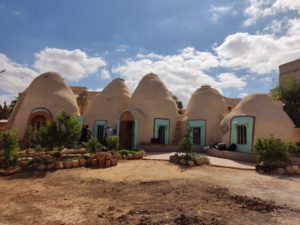Knowledge Related to Mud Architecture
Mud architecture is one of the architectural styles that have been used in the Hashemite Kingdom of Jordan together with stone and cement building materials. The materials used in this kind of architecture are very distinct in terms of local environment because they are available, cheap, and require simple techniques. Clay can be obtained from abandoned wells where it has been accumulated from rain and flood water. Straw can be added to the mixture of either red or black soil to strengthen the resulting mud bricks.
Mud architecture represents a cultural and social heritage and serves as a unique model for sustainability, achieving environmental, climatic, social, and economic principles. It is undoubtedly an environmentally friendly architecture, as its carbon footprint is arguably the lowest compared to other construction materials and methods.
Jordanian communities have known mud architecture since ancient times, for approximately 7,000 years. An example of this is the Abu Hamed site in northern Jordan Valley, where dwellings evolved from pits to circular shapes and then to more complex architectural forms, constructed with sun-dried mud bricks. In this context, specific architectural and interior design patterns emerged that reflect needs, functions, and environmental considerations.
The construction of mud houses is performed with the principle of cooperation among the different members of the community. In fact, building of mud houses is seen as a joint project done by all members of the local community. Women share in the process of restoration and preservation of mud houses is mainly done by women. This is normally done annually before the winter and women who did the job of smearing the mud or coating the houses with mud are called” Tayyanat.” The word is derived from the word Teen in Arabic, which means mud.
Another duty woman perform is motivating and encouraging men to work by singing traditional chants and songs related to construction. At the end of the construction, the owner of the house sacrifices a sheep or goat called the “Roof Sacrifice” prepared by women, to celebrate and bless the end of roofing as it is the final step of the construction. Usually, houses are decorated with religious writings.
The forms of construction by using mud in Jordan vary according to their uses, they are used in the tourist field: the construction of some decorations in hotels, and in the agricultural field: horse sheds and pigeon sheds, and others.


